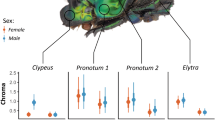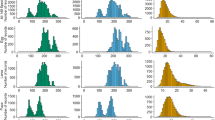Abstract
Climatic conditions, through their effects on resource availability, may affect important life history strategies and trade-offs in animals, as well as their interactions with other organisms such as parasites. This impact may depend on species-specific pathways of development that differ even among species with similar resource requirements (e.g., avian brood parasites and their hosts). Here we explore the degree of covariation between environmental-climatic conditions and nestling phenotypes (i.e., tarsus length, body mass, immune response to phytohemagglutinin injection) and ectoparasite loads of great spotted cuckoos (Clamator glandarius) and those of their magpie (Pica pica) hosts, both within and among 11 study years (1997–2011). Our main results were that (1) nestling phenotypes differed among years, but differently for great spotted cuckoos and magpies; (2) nestling phenotypes showed significant among-year covariation with breeding climatic conditions (temperature and precipitation); and (3) these associations differed for cuckoos and magpies for some phenotypic traits. As the average temperature at the beginning of the breeding season (April) increased, body mass and tarsus length increased only for cuckoos, but not for magpie hosts, while immune response decreased in both species. Finally, (4) the strength of the within-year relationships between the probability of ectoparasitism by Carnus hemapterus flies and laying date (used as an estimate of the within-year variation in climatic conditions) was negatively affected by the annual accumulated precipitation in April. These results strongly suggest that variation in climatic conditions would result in asymmetric effects on different species with respect to the probability of ectoparasitism, immunity and body size. Such asymmetric effects may affect animal interactions in general and those of brood parasites and their hosts in particular.






Similar content being viewed by others
References
Avilés JM, Stokke BG, Moksnes A, Røskaft E, Møller AP (2007) Environmental conditions influence egg color of reed warblers Acrocephalus scirpaceus and their parasite, the common cuckoo Cuculus canorus. Behav Ecol Sociobiol 61:475–485
Birkhead TR (1991) The magpies. The ecology and behaviour of black-billed and yellow-billed magpies. Poyser, London
Boggs CL, Inouye DW (2012) A single climate driver has direct and indirect effects on insect population dynamics. Ecol Lett 15:502–508
Calero-Torralbo MA, Václav R, Valera F (2013) Intra-specific variability in life-cycle synchronization of an ectoparasitic fly to its avian host. Oikos 122:274–284
Chen WH, Sun LT, Tsai CL, Song YL, Chang CF (2002) Cold-stress induced the modulation of catecholamines, cortisol, immunoglobulin M, and leukocyte phagocytosis in tilapia. Gen Comp Endocrinol 126:90–100
Cichon M, Dubiec A (2005) Cell-mediated immunity predicts the probability of local recruitment in nestling blue tits. J Evol Biol 18:962–966
Davies NB (2000) Cuckoos, cowbirds, and others cheats. Poyser, London
De Neve L, Soler JJ, Soler M, Pérez-Contreras T (2004) Differential maternal investment counteracts for late breeding in magpies Pica pica: an experimental study. J Avian Biol 35:237–245
De Neve L, Soler JJ, Ruiz-Rodríguez M, Martín-Gálvez D, Pérez-Contreras T, Soler M (2007) Habitat-specific effects of a food supplementation experiment on immunocompetence in Eurasian magpie Pica pica nestlings. Ibis 149:763–773
Del Grosso S, Parton W, Stohlgren T, Zheng DL, Bachelet D, Prince S, Hibbard K, Olson R (2008) Global potential net primary production predicted from vegetation class, precipitation, and temperature. Ecology 89:2117–2126
Douglas DJT, Newson SE, Leech DI, Noble DG, Robinson RA (2010) How important are climate-induced changes in host availability for population processes in an obligate brood parasite, the European cuckoo? Oikos 119:1834–1840
Gordo O, Sanz JJ (2006) Climate change and bird phenology: a long-term study in the Iberian Peninsula. Glob Change Biol 12:1993–2004
Grim T, Honza M (1997) Differences in parental care of reed warbler (Acrocephalus scirpaceus) to its own nestlings and parasitic cuckoo (Cuculus canorus) chicks. Folia Zool 46:135–142
Krüger O, Davies NB (2002) The evolution of cuckoo parasitism: a comparative analysis. Proc R Soc Lond B 269:375–381
Kutz SJ, Hoberg EP, Polley J, Jenskins EJ (2005) Global warming is changing the dynamics of Arctic host–parasite systems. Proc R Soc Lond B 272:2571–2576
Martínez J, Merino S (2011) Host-parasite interactions under extreme climatic conditions. Curr Zool 57:390–405
Martínez JG, Soler M, Soler JJ, Paracuellos M, Sánchez J (1992) Alimentación de los pollos de urraca (Pica pica) en relacion con la edad y disponibilidad de presas. Ardeola 39:35–48
Martín-Gálvez D, Soler JJ, Martínez JG, Krupa AP, Soler M, Burke T (2007) Cuckoo parasitism and productivity in different magpie subpopulations predict frequencies of the 457 bp allele: a mosaic of coevolution at a small geographic scale. Evolution 61:2340–2348
Martín-Gálvez D, De Neve L, Pérez-Contreras T, Soler M, Martínez JG, Soler JJ (2012) Manipulation of hunger levels affects great spotted cuckoo and magpie host nestlings differently. J Avian Biol 43:531–540
Merino S, Møller AP (2010) Host-parasite interactions and climate change. In: Møller AP, Fiedler W, Berthold P (eds) Birds and climate change. Oxford University Press, Oxford, pp 213–226
Merino S, Møller AP, de Lope F (2000) Seasonal changes in cell-mediated immunocompetence and mass gain in nestling barn swallows: a parasite-mediated effect? Oikos 90:327–332
Møller AP, Saino N (2004) Immune response and survival. Oikos 104:299–304
Møller AP, Arriero E, Lobato E, Merino S (2009) A meta-analysis of parasite virulence in nestling birds. Biol Rev 84:567–588
Møller AP, Saino N, Adamík P, Ambrosini R, Antonov A, Campobello D, Stokke BG, Fossøy F, Lehikoinen E, Martin-Vivaldi M, Moksnes A, Moskat C, Røskaft E, Rubolini D, Schulze-Hagen K, Soler M, Shykoff JA (2010) Rapid change in host use of the common cuckoo Cuculus canorus linked to climate change. Proc R Soc Lond B 278(106):733–738
Moreno J, Merino S, Sanz J, Arriero E, Morales J, Tomás G (2005) Nestling cell-mediated immune response, body mass and hatching date as predictors of local recruitment in the pied flycatcher Ficedula hypoleuca. J Avian Biol 36:251–260
Ndong D, Chen YY, Lin YH, Vaseeharan B, Chen JC (2007) The immune response of tilapia Oreochromis mossambicus and its susceptibility to Streptococcus iniae under stress in low and high temperatures. Fish Shellfish Immunol 22:686–694
Ots I, Kerimov AB, Ivankina EV, Ilyina TA, Hõrak P (2001) Immune challenge affects basal metabolic activity in wintering great tits. Proc R Soc Lond B 268:1175–1181
Payne RB (1973) Individual laying histories and the clutch size and number of eggs of parasitic cuckoos. Condor 75:414–438
Price PW (1980) Evolutionary biology of parasites. Princeton University Press, Princeton
Råberg L, Nilsson JA, Ilmonen P, Stjernman M, Hasselquist D (2000) The cost of an immune response: vaccination reduces parental effort. Ecol Lett 3:382–386
Roldán M, Soler M (2011) Parental-care parasitism: how do unrelated offspring attain acceptance by foster parents? Behav Ecol 22:679–691
Saino N, Calza S, Møller AP (1998) Effects of a dipteran ectoparasite on immune response and growth trade-offs in barn swallow, Hirundo rustica, nestlings. Oikos 81:217–228
Saino N, Rubolini D, Lehikoinen E, Sokolov LV, Bonisoli-Alquati A, Ambrosini R, Boncoraglio G, Møller AP (2009) Climate change effects on migration phenology may mismatch brood parasitic cuckoos and their hosts. Biol Lett 5:539–541
Sala OE, Gherardi LA, Reichmann L, Jobbagy E, Peters D (2012) Legacies of precipitation fluctuations on primary production: theory and data synthesis. Philos Trans R Soc Lond B 367:3135–3144
Sinclair JA, Lochmiller RL (2000) The winter immunoenhancement hypothesis: associations among immunity, density, and survival in prairie vole (Microtus ochrogaster) populations. Can J Zool 78:254–264
Soler JJ (1999) Brood parasites: the advantages of being different species. In: Adams NJ, Slotow R (eds) Proceedings of the 22nd international Ornithological Congress, Durban. BirdLife South Africa, Johannesburg, pp 3098–3106
Soler M, Soler JJ (1991) Growth and development of great spotted cuckoos and their magpie host. Condor 93:49–54
Soler JJ, Soler M (2000) Brood-parasite interactions between great spotted cuckoos and magpies: a model system for studying coevolutionary relationships. Oecologia 125:309–320
Soler M, Martínez JG, Soler JJ, Møller AP (1995) Preferential allocation of food by magpie Pica pica to great spotted cuckoo Clamator glandarius chicks. Behav Ecol Sociobiol 37:7–13
Soler M, Martínez JG, Soler JJ (1996) Effects of brood parasitism by the great spotted cuckoo on the breeding success of the magpie host: an experimental study. Ardeola 43:87–96
Soler JJ, Møller AP, Soler M, Martínez JG (1999) Interactions between a brood parasite and its host in relation to parasitism and immune defence. Evol Ecol Res 1:189–210
Soler JJ, Martínez JG, Soler M, Møller AP (2001) Coevolutionary interactions in a host-parasite system. Ecol Lett 4:470–476
Soler JJ, De Neve L, Pérez-Contreras T, Soler M, Sorci G (2003) Trade-off between immunocompetence and growth in magpies: an experimental study. Proc R Soc Lond B 270:241–248
Sorci G, Soler JJ, Møller AP (1997) Reduced immunocompetence of nestlings in replacement clutches of the european magpie (Pica pica). Proc R Soc Lond B 264:1593–1598
Statsoft Inc. (2011) STATISTICA (data analysis software system), version 10. www.statsoft.com
Studds CE, Marra PP (2011) Rainfall-induced changes in food availability modify the spring departure programme of a migratory bird. Proc R Soc B Biol Sci 278:3437–3443
Svensson E (1997) Natural selection on avian breeding time: casuality, fecundity- dependent, and fecundity-independent selection. Evolution 51:1276–1283
Václav R, Calero-Torralbo MA, Valera F (2008) Ectoparasite load is linked to ontogeny and cell-mediated immunity in an avian host system with pronounced hatching asynchrony. Biol J Linn Soc 94:463–473
Valera F, Casas-Criville A, Calero-Torralbo MA (2006) Prolonged diapause in the ectoparasite Carnus hemapterus (Diptera: Cyclorrhapha, Acalyptratae) - how frequent is it in parasites? Parasitology 133:179–186
Verboven N, Visser ME (1998) Seasonal variation in local recruitment of great tits: the importance of being early. Oikos 81:511–524
White TCR (2008) The role of food, weather and climate in limiting the abundance of animals. Biol Rev 83:227–248
Yang C, Stokke BG, Antonov A, Cai Y, Shi S, Moksnes A, Roskaft E, Møller AP, Liang W, Grim T (2013) Host selection in parasitic birds: are open-cup nesting insectivorous passerines always suitable cuckoo hosts? J Avian Biol 44:216–220
Zahraa HA (2008) Effects of commutative heat stress on immunoresponses in broiler chickens reared in closed system. Int J Poult Sci 7:964–968
Acknowledgments
We thank Anders Pape Møller, Manuel Soler, Gustavo Tomás and three anonymous reviewers for comments on previous versions of the manuscript that greatly improved the quality and clarity of the final version. Juan Manuel Peralta, Juan Gabriel Martínez and Gustavo Tomás helped at different stages of the field work. Funding was provided by the Spanish Ministerio de Ciencia e Innovación and European funds (FEDER) (CGL2010-19233-C03-01). Permission for sampling magpie nests and nestlings was obtained from the Junta de Andalucía (Spanish regional government of Andalucia).
Author information
Authors and Affiliations
Corresponding author
Additional information
Communicated by Indrikis Krams.
Electronic supplementary material
Below is the link to the electronic supplementary material.
Rights and permissions
About this article
Cite this article
Soler, J.J., De Neve, L., Martín-Gálvez, D. et al. Do climatic conditions affect host and parasite phenotypes differentially? A case study of magpies and great spotted cuckoos. Oecologia 174, 327–338 (2014). https://doi.org/10.1007/s00442-013-2772-y
Received:
Accepted:
Published:
Issue Date:
DOI: https://doi.org/10.1007/s00442-013-2772-y




